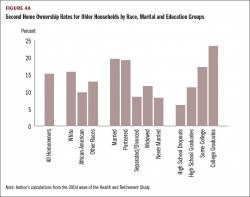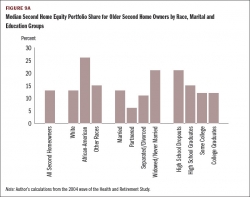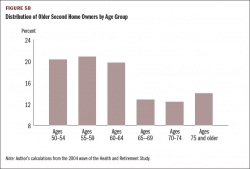Boomers - they bought Mustangs, mini-vans and now RVs. They created the suburbs and urban sprawl with 4-bedrooms ranches. What about in Key West? Many Key West Boomers cashed in on their homes in the early 2000’s, selling on the boom (to a lot of speculators) and leaving “paradise” for the real world. Fast forward to 2013 and beyond. Key West has been a second home haven for many years, but mostly to individuals and adventurers. How will a demographic powerhouse like the Boomers effect Key West second home real estate for the next many years? And how/what is necessary to reach them and help them to convince themselves that a primary or second home in Key West is affordable, enjoyable and fulfilling?
Second Home Boomer Notes
Overall, 15.2% percent of older homeowners own a second residence. A total of 92% of second-home owners were white, 5% were African-American, and 3% were those self-reporting other races. In terms of marital status, the two largest groups were married couples and the widowed, who comprised 73% and 12% of homeowners, respectively.
Financially, second-home owners are substantially better off than the typical homeowner. Median home equity in the main residence for older second-home owners was $170,000, compared to $100,000 for the typical homeowner. The median household income was $77,120, almost twice the income of the median homeowner of $43,560. Median wealth for second-home owners was $487,500, and mean wealth was over $1 million.
The median second home was worth $80,000, whereas the mean value was $197,341. (The great range between median and mean coming from second homes that range from the very modest to the very expensive.)
Typically second homes are purchased when the Boomer is in their late 40’s and 50’s. Often times this purchase is for a home that will be the second or future retirement home; but, for now is rented with periodic improvements - the significance of the improvement improving as occupany by the Boomer owner approaches (age 60 - 65) or visits becomes more frequent or longer (as the need for rental income recedes).
For the typical second-home owner, just 13 % of household wealth was in the equity of the second home. This portfolio share declines with education. This suggests that second homes are not specifically purchased and held for investment purposes as the property's wealth represents a very small portion of the owner’s portfolio.
Second, over half of Boomer second home owners spend barely two weeks per year in their second home.
Third, barely 13% of Boomers plan to make their second home their primary residence, depending on their job type and income source(s).
And fourth, on average, this second home is held for 15 years with the primary determinants to sell into the next stage of living being marital status (widow/widower) and health.
How big is Demand from Boomers for a Second Home?
There are over 45 million households aged 50 and over. Of this, 7 million have a second home and less than 1.5 million have a mortgage. These second homes are often inherited or cash buys.
(Note: Nationwide, cash sales account for 30 -35% of all sales. Fellow Key West Realtors tell me their cash deals are 60% of their total and cover all price levels. Three of my last four deals went to cash young Boomer buyers (each one from out of the State.))
Are Boomers moving from the suburbs to urban areas? Not really. Across all demographics; race, marital status, income and education, suburban Boomers move to other suburban areas 80% of the time. Only in large metropolitan areas is there significant surburban to urban movement by Boomers - 12%. If patterns from 1990 forward hold true, barely 2% of Boomers are expected to "go urban".
Is Key West urban or small town?
Since buying a second home is a choice, various factors weigh in. Primary among them are:
- Proximity to Healthcare
- Proximity to shops and restaurants
- Closeness of family (Let's visit Nana and Poppa in Key West)
- Quality of life
- Education facilities (Formal or informal for scholastic or self-improvement)
- Ease of transportation; public, walk, pedal
Does Key West satisfy these criteria? Some more than others. Likewise, you can see how the age of the Boomer might place more emphasis on some criteria than others.
A younger Boomer might focus on Quality of life (Arts, eateries, beautiful boutiques, water activities and pedaling around town easily, especially if living in Old Town)
A senior Boomer might focus more on Healthcare and seeing their family more often. Some of these concerns are being remedied with improvements to the Lower Keys Medical Center and the increased capacity and expanding flight schedule at the Key West International Airport.
Where are the Boomers?
Boomers are joiners. They join Rotary, Kiwanis and Knights of Columbus. They belong to Alumni Associations and military retirement organizations. In Key West they belong to literary societies and seek out diverse and interesting entertainment .
On the internet find Boomers in Groups on LinkedIn, Facebook and Twitter (For example, search #Boomer).
Boomers have built relationships their entire adult life. Offer service and a relationship cause it's who's in front of the money, not the money, that counts.
Conclusion
Boomers are buying Key West second homes; but, it is not that a large percentage of them are buying second homes; rather, that a small, select percentage of a very large pool is buying.
If you have any comments or questions, please contact me here.
Thank you and good luck!
Additional Resources:










